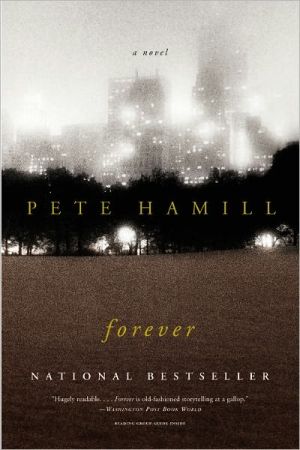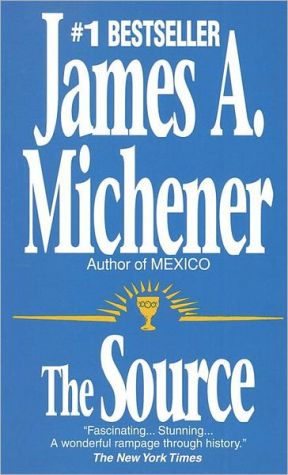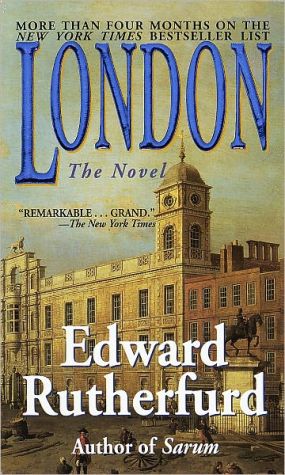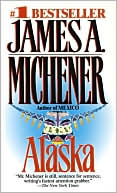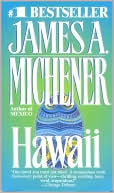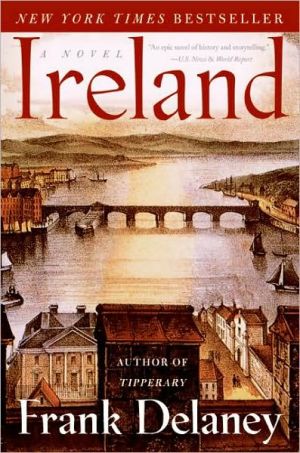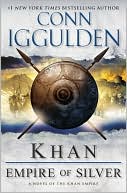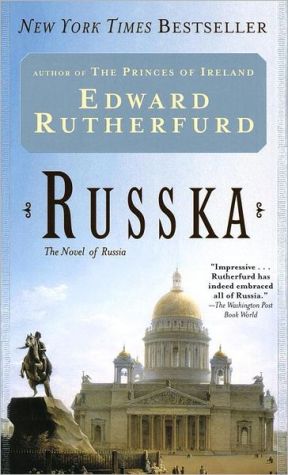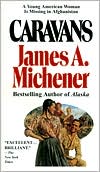Forever
This widely acclaimed bestseller is the magical, epic tale of an extraordinary man who arrives in New York in 1740 and remains ... forever. Through the eyes of Cormac O'Connor - granted immortality as long as he never leaves the island of Manhattan - we watch New York grow from a tiny settlement on the tip of an untamed wilderness to the thriving metropolis of today. And through Cormac's remarkable adventures in both love and war, we come to know the city's buried secrets - the way it has...
Search in google:
This widely acclaimed bestseller is the magical, epic tale of an extraordinary man who arrives in New York in 1740 and remains ... forever. Through the eyes of Cormac O'Connor - granted immortality as long as he never leaves the island of Manhattan - we watch New York grow from a tiny settlement on the tip of an untamed wilderness to the thriving metropolis of today. And through Cormac's remarkable adventures in both love and war, we come to know the city's buried secrets - the way it has been shaped by greed, race, and waves of immigration, by the unleashing of enormous human energies, and, above all, by hope.The New YorkerIf September 11th was a terrible warning of New York's mortality, Hamill's entertaining panhistorical fantasy is a paean to its immortality. In 1740, an Irish Jew named Cormac O'Connor heads to New York in pursuit of the man who killed his father and gets tangled up in a rebellion against the English. Through a series of events involving an African slave with shamanistic powers, he is granted eternal life, provided that he never leaves Manhattan. There follows a tour of the city's history through Cormac's eyes: the political corruption and the poverty, but also the majestic growth of the metropolis through its culture, its buildings, and its people. The book's central conceit could almost have come from the pages of Twain or Bellamy, but Hamill pulls his story fiercely into the present by centering the final phase of Cormac's narrative on the World Trade Center attacks themselves.
Forever\ \ By Pete Hamill \ Back Bay Books\ Copyright © 2003 Deidre Enterprises\ All right reserved.\ ISBN: 0-316-73569-8 \ \ \ \ Chapter One\ And what a people loves it will defend. We took their temples from them and forbade them, for many years, to worship their strange idols. They gathered in secret, deep in the dripping glens, Chanting their prayers before a lichened rock. - John Hewitt, "The Colony," 1950\ There he is, three days after his fifth birthday, standing barefoot upon wet summer grass. He is staring at the house where he lives: the great good Irish place of whitewashed walls, long and low, with a dark slate roof glistening in the morning drizzle. Standing there, he knows it will turn pale blue when the sun appears to work its magic.\ The boy named Robert Carson loves gazing at that house, basking in its permanence and comfort. On some days, a wisp of smoke rises from the chimney. On other days, the earlymorning sun throws a golden glaze upon its white facade. It is never the same and always the same. He sees the small windows like tiny eyes in the face of the house, the glass reflecting the rising sun. The front door is mahogany, salvaged from some drowned ship along the shores of the Irish Sea, as tightly fitted in that doorway now as any man could make it. There's a low half-door too, placed in front of the full mahogany door like a snug wooden apron. During balmy summer days, the large door is always open, welcoming light and air into the house. The breeze pushes smoke from the fire up through the stone chimney.\ Robert Carson goes in, flipping the iron latches made by his father, whose name is John Carson and is called simply Da. The house is as it always is and as the boy thinks it will always be. A sweet odor of burning turf fills the air. He breathes it deeply, inhaling the ancient burned mud of the swamps beside Lough Neagh, where the peat was cut from the bog. Directly facing him is the jamb wall, running from floor to ceiling along the side of the hearth. A diamond-shaped spy hole is cut into its pine boards so that he and his father and mother can observe the approach of strangers. The boy can only do this by standing on the shoulder of the hearth.\ The hearth is at the end of a large main room, but it is the center of the house, the holy place that holds the fire. A wide iron canopy rises above the hearth, carrying away the smoke, and on damp, chilly days the boy sits on one of the hand-carved low benches beside the fire. The family has few visitors, but men always sit on the right, facing the fire, so the boy does the same. The women take the bench on the left, and his mother is always there. Her name is Rebecca, but he calls her Ma. He thinks of them as a unit: Ma, Da, and me. The Carsons. To the left of the hearth is the small iron crane his father made in the forge, with its arms of different lengths, and hooks for hanging pots. His mother moves the pots back and forth, in and out of the flame, while the odors of stews and porridges and soups overwhelm the sweetness of the burning turf. There are two low threelegged chairs called "creepies," cousins of milking stools. Built low in the days before chimney flues so that farmers could breathe below the smoke. One day he lifted a creepy, examined the perfect pegs that held the legs so permanently to the seat, and hugged it to his chest, thinking: This is ours, this belongs to the Carsons. Back about five feet from the hearth is his father's own chair, made of woven rush, looking like a throne designed as a beehive. Robert Carson never sits in his father's chair.\ Beside his father's chair is one of the many wrought-iron light holders that John Carson made in the forge, long iron poles with four arched feet and hooks that hold lanterns for his reading. They never wobble on the flagstone floor, never lose their dignity. A wide oaken shelf spreads above the hearth and he can see with his eyes shut the objects that occupy its oiled surface: his father's clay pipes, with their long curved stems, an old thatched horse collar that Da saved from his own youth, a carved wooden cup called a noggin, found in the mud of a bog. Da has told the boy that the noggin is a thousand years old, and Robert Carson is certain that his father is right. To the left, a mound of turf bricks rises off the floor, dried out of dark black bottom mud. The iron tools of the fire, smaller cousins of the light holders, stand as rigid as sentries.\ All are part of the hearth, where the fire burns low but is never allowed to go out. As the center of the house, the hearth gives off warmth and food, and is the place to which the Carsons turn in the evenings for talk and even song. On his birthday, while they faced the hearth, his mother told the boy that his magic number would be nine, for he was born on the ninth of September.\ "Do you see, son? You were born on the ninth day of the ninth month," his mother said, "and as you grow up, lad, you'll learn: Nine will be your number."\ Sometimes on rainy afternoons, when his father is working in the forge, the boy's mother sits beside the fire to drink tea and eat oat bread while she tells stories. The boy listens silently, the stories entering him in such a way that he later thinks they have happened to him, that he has lived them. Sometimes he drowses, while her voice makes a kind of music. They are the first stories of his life, written on a five-year-old's emptiness. He is awake and asleep at the same time, listening to the magical words, while becoming through his mother's magic the people in the stories. The fire burns steadily in the hearth, and his mother tells him that the fire should never be allowed to go out, because if it does, the soul leaves the house.\ Da agrees. There were houses in Ireland, he said once, where the fire had burned day and night for more than a hundred years. In this house, he said, it had burned since John and Rebecca Carson moved in, long ago, before the boy was born. Even as she whispers stories, his mother gazes at the fire, as if seeing people or things unseen by others. Robert Carson later learns that before he was born there were two other children, his brothers, who were born and then died in another house. And when they died, Da poured water into the hearth and moved to this place to begin again. Robert Carson tries (after learning this when he is eight) to imagine those lost brothers, but no faces ever come clear. In bad dreams they have heads with shiny surfaces but no eyes or noses or mouths, and those visions wake him from his sleep. Sometimes he is terrified.\ To the left of the hearth is the door to the bedroom where his mother and father sleep each night. A dresser stands outside the door, its drawers holding clothes. On its top there's a wooden tray of knives and forks and spoons, along with a clump of gorse or primrose standing in water in the family's only piece of delft: a tall vase decorated with tulips. Sometimes the boy traces with his fingers the designs on the vase, and caresses its smooth surface. Above the dresser three shelves are cut into the wall, stacked with terra-cotta plates and cups and bowls made by hand in the Mountains of Mourne. To the left is the back door, leading to the West. The room is dominated by the table behind the chairs that face the hearth, its dark planed top burnished by endless cleanings and oilings.\ Sometimes he stares at the back door, the one that opens to the West. He knows that no stranger should ever leave through the back door because he would take with him the luck of the house. He knows too that when there's a death in the house, the coffin must leave through that same back door, to be taken to the West, to the setting sun and the blackness that follows.\ On the ceiling, great beams cut from bog oak form a huge A, supporting the layers of thatch and sod, tied firmly with fir rods, that lie beneath the slates. His father built this house to last. The roof rests on towers of chiseled stone that form the gable ends, each slab thirty inches thick, cut so fine that they fit together without mortar. The walls are brick, stone, cut rushes that had soured, all bound together and made smooth by river mud and lime wash. They are two feet thick. A house built like a fortress. Even when he is alone, he is safe.\ (Continues...)\ \ \ \ \ Excerpted from Forever by Pete Hamill Copyright © 2003 by Deidre Enterprises. Excerpted by permission.\ All rights reserved. No part of this excerpt may be reproduced or reprinted without permission in writing from the publisher.\ Excerpts are provided by Dial-A-Book Inc. solely for the personal use of visitors to this web site. \ \
\ From Barnes & NobleIn Forever, Pete Hamill's paean to his hometown, the main character, one Cormac O'Connor, receives the gift of immortality with one condition: he must spend all his days on the island of Manhattan. This Whitmanesque dream, enacted in 1741, makes O'Connor a sort of undying resident muse of this ever-bulging metropolis. After September 11th, it is reassuring to read this novel as veteran New Yorker Hamill's lovestruck tribute to our most cosmopolitan city.\ \ \ \ \ The New YorkerIf September 11th was a terrible warning of New York's mortality, Hamill's entertaining panhistorical fantasy is a paean to its immortality. In 1740, an Irish Jew named Cormac O'Connor heads to New York in pursuit of the man who killed his father and gets tangled up in a rebellion against the English. Through a series of events involving an African slave with shamanistic powers, he is granted eternal life, provided that he never leaves Manhattan. There follows a tour of the city's history through Cormac's eyes: the political corruption and the poverty, but also the majestic growth of the metropolis through its culture, its buildings, and its people. The book's central conceit could almost have come from the pages of Twain or Bellamy, but Hamill pulls his story fiercely into the present by centering the final phase of Cormac's narrative on the World Trade Center attacks themselves.\ \ \ Publishers WeeklyThis novel demands that the reader immediately suspend disbelief, but if this summons is heeded the reward will be a superior tale told by Hamill (Snow in August; A Drinking Life) in the cadence of the master storyteller. The year is 1741 and this is the story of Cormac O'Connor-"Irish, and a Jew"-who grows up in Ireland under English Protestant rule and is secretly schooled in Gaelic religion, myth and language. Seeking to avenge the murder of his father by the Earl of Warren, he follows the trail of the earl to New York City. On board ship, Cormac befriends African slave Kongo, and once in New York, the two join a rebellion against the British. After the rising is quelled, mobs take to the streets and Kongo is seized. Cormac saves Kongo from death, but is shot in the process. His recovery takes a miraculous turn when Kongo's dead priestess, Tomora, appears and grants Cormac eternal life and youth-so long as he never leaves the island of Manhattan, thus the "Forever" of the title. What follows is a portrait of the "city of memory of which Cormac was the only citizen." Cormac fights in the American Revolution, sups with Boss Tweed (in a very sympathetic portrait) and lives into the New York of 2001. In that year he warily falls in love with Delfina, a streetwise Dominican ("That was the curse attached to the gift: You buried everyone you loved"), and comes into contact with a descendant of the Earl of Warren, the newspaper publisher Willie Warren. His love, his drive for revenge and his very desire to exist are fatefully challenged on the eve and the day of September 11. This rousing, ambitious work is beautifully woven around historical events and characters, but it is Hamill's passionate pursuit of justice and compassion-Celtic in foundation-that distinguishes this tale of New York City and its myriad peoples. 4-city author tour. (Dec.)\ \ \ \ \ KLIATTCormac O'Connor is a young man with many secrets. His mother was a secret Jew in 1730s Ireland, his father a pagan Irishman following the old gods in secret as he and his wife adopt Protestant names and attend the local Anglican church for safety. After his mother is run over by the local Earl's carriage and his father later murdered by the same man, Cormac swears revenge according to the ways of the old Irish people-he must avenge his parents' deaths by killing the Earl. When the Earl flees to New York, Cormac follows. On the passage over, he helps and befriends several Africans recently enslaved who will be sold in the Manhattan slave markets on their arrival. One in particular, Kongo, is rumored to be a powerful shaman of his people and returns Cormac's kindness to him by assisting him in his quest to kill the Earl. After being mortally wounded during his act of revenge, Cormac is saved by Kongo through a magical ceremony in which he is granted immortal life, provided he stays on the island of Manhattan. And so Cormac's destiny is launched. The book zeros in on his life at various points in New York history; during the American Revolution, the corrupt 1830s, his friendship with Boss Tweed, and his final destiny as he falls in love with modern-day Delfina, a beautiful Dominican who will release him from this life and allow him to move into the afterlife-if he wants to. Pete Hamill is well known for his ability to make New York history come alive and this work is no exception. Hamill pays particular attention to weaving into his narrative the prominent role African Americans have played in New York history. An interview with the author and a reading group guide can be found at the end ofthe book. Some sex and violence render this work more appropriate for senior high and public library collections. This is a wonderful addition to historical fiction or fantasy collections. KLIATT Codes: SA-Recommended for senior high school students, advanced students, and adults. 2003, Little Brown, Back Bay, 613p., Ages 15 to adult. \ — Courtney Lewis\ \ \ \ \ Library JournalRobert Carson is happy as the son of a blacksmith in Ireland in the early 1700s. When his mother is killed by the carriage of the Earl of Warren, that idyllic life is ended, and Robert finds that he is really Cormac O'Connor, a son of the old Irish. When Cormac's father is murdered by the Earl's men, he must seek vengeance, forcing him to sail to America. While aboard ship, Cormac befriends the slaves being held below deck, a friendship that will last many lifetimes, for Kongo, one of the slaves, is a babalawo-an African shaman. He gives Cormac the gift of eternal life, with the condition that Cormac must stay on the island of Manhattan. Thus Cormac's tale becomes the story of Manhattan and follows the city through generations of change. The abridgment is well edited, containing all the major plot lines of the book, and is much easier to follow. Stevie Ray Dallimore's performance is energetic; he does a very good job with the various dialects and helps maintain the pace of the work. The unabridged program, narrated by Henry Strozier, is almost impossible to get through; it is tedious and annoying. Hamill's text spends too much time on the various parts of the male anatomy and the smell of the city. Most libraries would be better served by the abridged version of this historical fantasy.-Theresa Connors, Arkansas Tech Univ., Russellville Copyright 2003 Reed Business Information.\ \ \ \ \ Kirkus ReviewsJournalist and author Hamill (the novel Loving Women, 1989; Why Sinatra Matters, 1998, etc.) offers a chronicle of 250 years of Manhattan life as experienced by an immortal Irish immigrant. Growing up in the Ulster countryside in the 18th century, Robert Carson was constantly regaled with tales of the chieftains and warriors who'd fought over Erin across the centuries. As a Protestant, Robert was inclined to have more sympathy than most Irishmen with the English and Scots-until his mother was killed by the English Earl of Warren and Robert's father revealed to him that his true name was Cormac O'Connor. The O'Connors have secretly preserved the Irish language and the ancient (pre-Christian) religion, and Cormac is now inducted into the family mysteries. Vowing revenge for his mother's death, he sets off in pursuit of Warren but finds that he's left for America. So Cormac boards ship and lands in Manhattan in 1741. Soon, he gets work in a printing shop run by a German immigrant named John Peter Zenger, eventually becoming a kind of journalist who roams the city's back alleys and reports the gossip and events of the day. In the aftermath of a slave revolt, Cormac saves the life of an African magician and is granted the power of immortality-provided he never sets foot off Manhattan Island. Not a bad deal, since it allows the ever-observant Cormac to be eyewitness to some of history's greatest spectacles-from the American Revolution to the Draft Riots, from the rise and fall of Tammany Hall to the stock market crash. Oh, and that business of September 11, 2001, too. Like all real New Yorkers, Cormac doesn't mind being trapped in Manhattan: He's doesn't even know there's anywhere else. Atrue Hamill piece: by turns fascinating, sentimental, hackneyed, and provincial in the best New York mode. It won't play in Poughkeepsie, but there are plenty of New Yorkers (and New York-ophiles) who will love it.\ \
